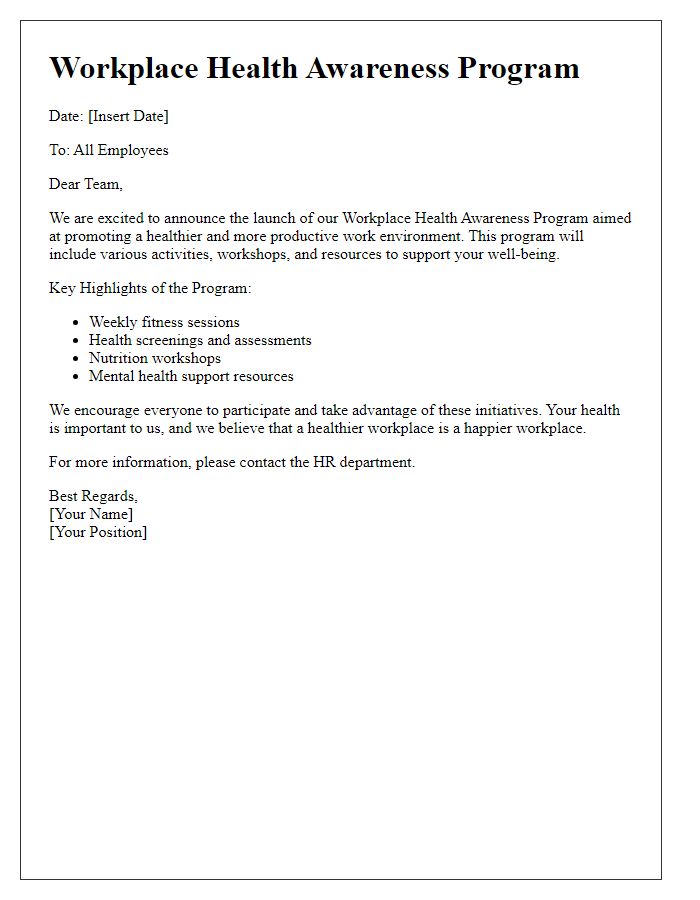In today's fast-paced world, maintaining our health often takes a back seat, but it doesn't have to. With rising awareness about preventive care and healthy habits, it's crucial to engage our community in meaningful conversations about wellness. From nutritious diets to regular exercise, small changes can lead to big impacts on our health and happiness. Join us as we explore effective strategies to boost our well-beingâread on for more insights!

Target Audience Identification
Health awareness campaigns play a crucial role in educating and influencing communities regarding various health issues. A target audience typically includes demographics such as age groups (children, teenagers, adults, seniors), socioeconomic status (income levels influencing healthcare access), and specific communities (urban or rural locations). Understanding these audiences can ensure tailored messaging. For instance, campaigns focused on diabetes awareness might target adults aged 40-60 in urban areas where fast food consumption is high. Meanwhile, mental health initiatives could prioritize teenagers in high schools, where stressors like academic pressure are prevalent. Utilizing social media platforms like Instagram or TikTok can effectively reach younger audiences, while traditional media such as newspapers may better engage older demographics. Recognizing lifestyle habits, cultural backgrounds, and existing health concerns within each group enables a more mindful approach to crafting messages that resonate and compel action.
Clear and Concise Messaging
Health awareness campaigns focus on educating communities about important health issues, such as diabetes, obesity, or mental health. Effective messaging should be clear, using statistics (like 34.2 million Americans with diabetes) and relatable stories to resonate with the audience. Events, such as National Health Observances, offer platforms to disseminate information, using brochures and social media to reach diverse demographics. Locations like community centers and schools can serve as hubs for workshops, inviting local health professionals for discussions. Visual aids, including infographics, highlight key facts, making complex information more accessible. Engaging the public through testimonials enhances credibility, reinforcing the message's importance in promoting healthier lifestyles.
Visual and Graphic Design Elements
Health awareness campaigns often utilize eye-catching visual and graphic design elements to effectively convey important messages. Bright colors like red or green (commonly associated with health and urgency) capture attention while infographics present statistics, such as the 1 in 4 adults experiencing mental health issues, in an easily digestible format. Symbols, such as crossed-out cigarettes for smoking cessation or heart icons for cardiovascular health, deliver immediate understanding of complex concepts. The choice of typography plays a critical role; bold, clear fonts ensure readability even at a distance, essential for posters in public places like community centers or events. Overall, strategic graphic design enhances engagement, making health information more accessible and memorable to diverse audiences.
Call to Action
Health awareness campaigns aim to educate communities about critical health issues, promoting preventive measures and healthy lifestyles. Engaging statistics, like the 1 in 3 adults experiencing chronic health conditions in the United States, highlight the urgency of this mission. Events such as health fairs or workshops in local venues, like community centers or schools, facilitate the sharing of knowledge on nutrition, physical fitness, and mental health. Mobilizing volunteers and healthcare professionals fosters a sense of community involvement, empowering individuals to take charge of their health. Clear calls to action, encouraging residents to participate in screenings and wellness activities, can significantly impact public health outcomes.
Monitoring and Feedback Mechanisms
Health awareness campaigns often utilize monitoring and feedback mechanisms to evaluate their effectiveness and engage participants. Establishing measurable objectives, such as tracking changes in participant knowledge levels after workshops, can provide valuable insights. Feedback tools, including surveys and focus groups, can capture participant experiences and perceptions regarding health topics, such as nutrition and exercise. Data analysis from these instruments helps organizations refine program content and delivery methods. Regular monitoring of engagement metrics, such as attendance rates at community events, allows for timely adjustments to enhance outreach. Effective communication of campaign results to stakeholders fosters transparency and encourages continued support for health initiatives.













Comments